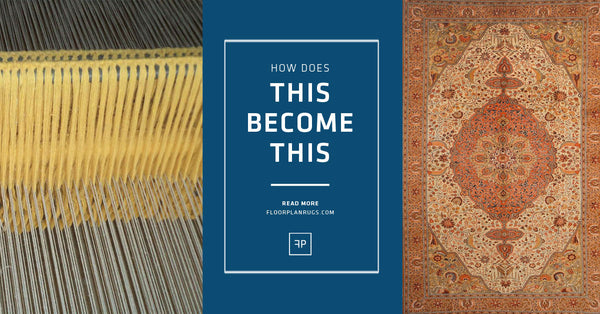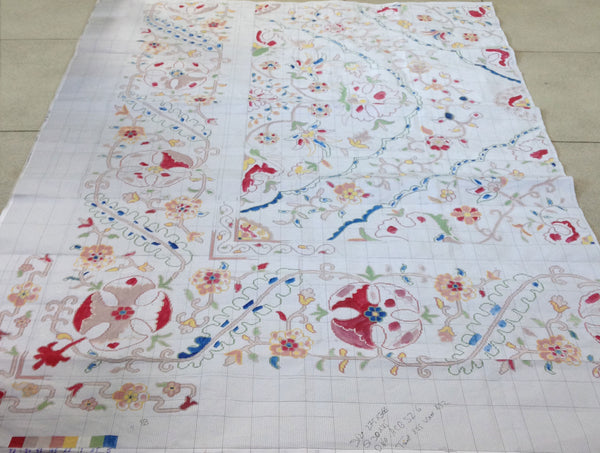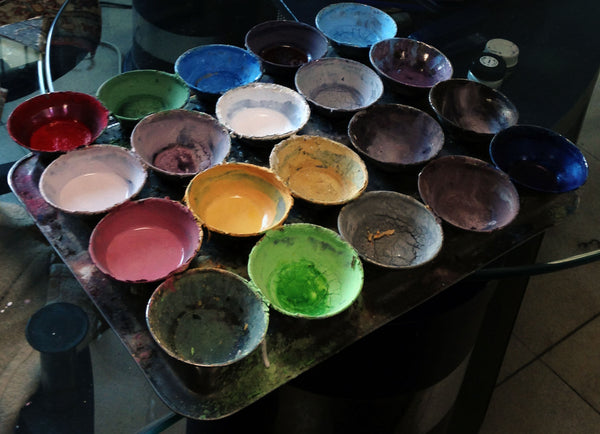- Continue Shopping
- Your Cart is Empty
From Sketch to Loom: The Shorthand of Knotting Rugs

With hundreds of thousands, or millions, of knots, how do the weavers get even the most complicated designs so perfectly perfect?
Skill, of course, but also an orchestrated process among many expert craftsmen.

The process of preparing a design for weaving is not dissimilar from the way comics are drawn: outlines first, then color. A trained designer will pencil sketch the outlines of a classic or new design onto a very large graph paper, square by square. A colorist — sometimes the same person, but usually another craftsman — will carefully paint in the design, being sure to indicate areas where edges should be softened with a darker or lighter shade.

For a rug that will be symmetrical, either as an all-over motif or a central medallion, only one quarter of the rug’s whole design is prepared in this way — the paper is then simply rotated to complete the other sections.
All of this preparation takes place in the design center of a workshop; the weaving will take place elsewhere in the workshop, on a large, vertical loom.

Depending on the complexity of the design and size of the rug, the weaver may dedicate up to a year to complete it. Their guide is the design that has been provided to them — but not all weavers use it in the same way.

Some weavers prefer to work directly off of the design paper, folding it down to the section they’re working on and tucking it into the loom’s thread above the area where they are working. Others, however, want an even more concise process of interpretation. For these weavers, the drawing is transcribed into a kind of text-based short hand:
Row 1: Bbbbyyyyrrrrwwwbbwwbbyy
It looks complicated, but it’s actually quite simple: each letter stands for the color of the knot to be tied, in this particular order. When the short hand ends, the weaver repeats it. If there are variations for different segments, those are transcribed in the same way. Most weavers also tuck this paper into the thread of their loom above their workspace.
These simple tools act as their guides to create magnificent works of art.
(Note: There is a whole class of village rugs that are one-of-a-kind and often have minor imperfections or nuances; these are often made by memory by women in the family. You can forgive them these minor peccadillos, which, for many collectors, make the most desirable rugs to find).
Featured Products
-
AKINA Collection Wool Rug in CHARCOAL / TAUPE
$349 $439 Why this price?
Hand woven in India, the Akina Collection sets a rugged and worldly foundation. Each piece is deliberately crafted with textural highs and lows, accentuating the all-over geometric pattern. And because...
-
BARKLEY Collection Wool/Viscose Rug in MOCHA
$429 $539 Why this price?
Breathe order, balance and calm into any setting with the new, hand-loomed Barkley Collection. These linear, tonal designs in wool and shimmery viscose are at once casual, chic and ultra...
-
EDGE Collection Rug in IVORY
$99 $129 Why this price?
Give your room an all-natural feel with the Edge Collection. These earthy rugs are hand woven in India of alternating strips of leather and jute for a unique tactile feel...
-
OAKWOOD Collection Wool Rug in GRAVEL
$179 $229 Why this price?
The flatwoven Oakwood Collection is an earthy neutral that benefits from natural, dye-free wool. The handwoven rugs have an intricate speckled look, thanks to the nature of pure, fine wool....
-
Omen Collection Wool Rug in Grey
$349 $439 Why this price?
Hand-woven of jute, wool and cotton in India, the Omen Collection is a timeless series. The subtle chevron waves add beautiful dimension and create a truly unique look that is...
-
PROMENADE Collection Rug in BROWN
$431.20 $539 Why this price?
Sold Out
Hand stitched in India of 100% authentic cowhide, Promenade is a contemporary version of the timeless cowhide rug. The modern collection offers patterns that range in graphic designs with a...
-
PROMENADE Collection Rug in SADDLE
$679 $959 Why this price?
Sold Out
Hand stitched in India of 100% authentic cowhide, Promenade is a contemporary version of the timeless cowhide rug. The modern collection offers patterns that range in graphic designs with a...
-
PROMENADE Collection Rug in MULTI
$434.40 $543 Why this price?
Sold Out
Hand stitched in India of 100% authentic cowhide, Promenade is a contemporary version of the timeless cowhide rug. The modern collection offers patterns that range in graphic designs with a...
-
ORIAN SHAG Collection Rug in CHARCOAL
$229 $289 Why this price?
Sold Out
A luxe, head-turning series of shag rugs, Orian is machine made in China of 100% polyester for great durability and exceptional softness. The densely packed yarns also make Orian a...
-
KALLIOPE Collection Rug in BLUE / MULTI
$207.20 $259 Why this price?
Sold Out
Inspired by old Ben Ourian rugs, we've collaborated with Designer Justina Blakeney to transform the look with her signature 'Jungalow' style. The result is a series of wild patterns and...
-
KALLIOPE Collection Rug in SAND / RUST
$207.20 $259 Why this price?
Sold Out
Inspired by old Ben Ourian rugs, we've collaborated with Designer Justina Blakeney to transform the look with her signature 'Jungalow' style. The result is a series of wild patterns and...
-
PROMENADE Collection Rug in SAND
$434.40 $543 Why this price?
Sold Out
Hand stitched in India of 100% authentic cowhide, Promenade is a contemporary version of the timeless cowhide rug. The modern collection offers patterns that range in graphic designs with a...
-
AKINA Collection Wool Rug in IVORY / BEIGE
$419 $529 Why this price?
Sold Out
Hand woven in India, the Akina Collection sets a rugged and worldly foundation. Each piece is deliberately crafted with textural highs and lows, accentuating the all-over geometric pattern. And because...
-
SLOANE Collection Rug in SKY
$599 $749 Why this price?
A perfect blend of refined and relaxed, the Sloane Collection is hand-woven of wool, cotton and polyester by artisans in India. Sloane offers a sophisticated foundation for a contemporarily bohemian...
-
SLOANE Collection Rug in SMOKE
$599 $749 Why this price?
A perfect blend of refined and relaxed, the Sloane Collection is hand-woven of wool, cotton and polyester by artisans in India. Sloane offers a sophisticated foundation for a contemporarily bohemian...
-
SLOANE Collection Rug in NATURAL
$599 $749 Why this price?
A perfect blend of refined and relaxed, the Sloane Collection is hand-woven of wool, cotton and polyester by artisans in India. Sloane offers a sophisticated foundation for a contemporarily bohemian...
-
SLOANE Collection Rug in OATMEAL
$599 $749 Why this price?
A perfect blend of refined and relaxed, the Sloane Collection is hand-woven of wool, cotton and polyester by artisans in India. Sloane offers a sophisticated foundation for a contemporarily bohemian...
-
SLOANE Collection Rug in MIST
$599 $749 Why this price?
A perfect blend of refined and relaxed, the Sloane Collection is hand-woven of wool, cotton and polyester by artisans in India. Sloane offers a sophisticated foundation for a contemporarily bohemian...
-
ROMAN Collection Rug in IVORY / BLACK
$219 $269 Why this price?
A perfect blend of refined and relaxed, the Roman Collection is hand woven of wool, cotton and viscose by skilled artisans in India. Designs with meticulously placed strokes offer a...
-
ROMAN Collection Rug in IVORY / PEBBLE
$219 $269 Why this price?
A perfect blend of refined and relaxed, the Roman Collection is hand woven of wool, cotton and viscose by skilled artisans in India. Designs with meticulously placed strokes offer a...
-
ROMAN Collection Rug in NATURAL / CHARCOAL
$219 $269 Why this price?
A perfect blend of refined and relaxed, the Roman Collection is hand woven of wool, cotton and viscose by skilled artisans in India. Designs with meticulously placed strokes offer a...
-
ROMAN Collection Rug in IVORY / GRANITE
$219 $269 Why this price?
A perfect blend of refined and relaxed, the Roman Collection is hand woven of wool, cotton and viscose by skilled artisans in India. Designs with meticulously placed strokes offer a...
-
ROMAN Collection Rug in NATURAL / BARK
$219 $269 Why this price?
A perfect blend of refined and relaxed, the Roman Collection is hand woven of wool, cotton and viscose by skilled artisans in India. Designs with meticulously placed strokes offer a...
-
REY Collection Rug in IVORY / CHARCOAL
$129 $159 Why this price?
Hand-woven of 100% polyester by artisans in India, the Rey Collection features new solids elevated by tonal texture. Created in collabration with Justina Blakeney, the multi-colored yarn and stitching creates...
-
REY Collection Rug in SPA / NATURAL
$129 $159 Why this price?
Hand-woven of 100% polyester by artisans in India, the Rey Collection features new solids elevated by tonal texture. Created in collabration with Justina Blakeney, the multi-colored yarn and stitching creates...
-
REY Collection Rug in DENIM / NATURAL
$129 $159 Why this price?
Hand-woven of 100% polyester by artisans in India, the Rey Collection features new solids elevated by tonal texture. Created in collabration with Justina Blakeney, the multi-colored yarn and stitching creates...
-
REY Collection Rug in SILVER / GREY
$129 $159 Why this price?
Hand-woven of 100% polyester by artisans in India, the Rey Collection features new solids elevated by tonal texture. Created in collabration with Justina Blakeney, the multi-colored yarn and stitching creates...
-
REY Collection Rug in CAMEL / BLACK
$129 $159 Why this price?
Hand-woven of 100% polyester by artisans in India, the Rey Collection features new solids elevated by tonal texture. Created in collabration with Justina Blakeney, the multi-colored yarn and stitching creates...
-
QUARRY Collection Wool Rug in STONE
$149 $189 Why this price?
Hand-woven in India of 100% wool, the Quarry Collection sets a refined, heavily textured tone that can work in any space. Available in three timeless neutrals.
-
QUARRY Collection Wool Rug in IVORY
$149 $189 Why this price?
Hand-woven in India of 100% wool, the Quarry Collection sets a refined, heavily textured tone that can work in any space. Available in three timeless neutrals.
-
QUARRY Collection Wool Rug in OATMEAL
$149 $189 Why this price?
Hand-woven in India of 100% wool, the Quarry Collection sets a refined, heavily textured tone that can work in any space. Available in three timeless neutrals.
-
PROMENADE Collection Rug in SILVER
$619 $779 Why this price?
Hand stitched in India of 100% authentic cowhide, Promenade is a contemporary version of the timeless cowhide rug. The modern collection offers patterns that range in graphic designs with a...
-
PROMENADE Collection Rug in IVORY
$619 $779 Why this price?
Hand stitched in India of 100% authentic cowhide, Promenade is a contemporary version of the timeless cowhide rug. The modern collection offers patterns that range in graphic designs with a...
-
PROMENADE Collection Rug in CHARCOAL
$619 $779 Why this price?
Hand stitched in India of 100% authentic cowhide, Promenade is a contemporary version of the timeless cowhide rug. The modern collection offers patterns that range in graphic designs with a...
-
PROMENADE Collection Rug in GREY
$619 $779 Why this price?
Hand stitched in India of 100% authentic cowhide, Promenade is a contemporary version of the timeless cowhide rug. The modern collection offers patterns that range in graphic designs with a...
-
PROMENADE Collection Rug in IVORY / GREY
$619 $779 Why this price?
Hand stitched in India of 100% authentic cowhide, Promenade is a contemporary version of the timeless cowhide rug. The modern collection offers patterns that range in graphic designs with a...
-
PRIYA Collection Wool/Viscose Rug in Bone / Bluestone
$119 $149 Why this price?
Hand-woven by skilled artisans in India, the Priya Collection offers beautiful tonal designs accentuated by a carefully curated color palette. Delicate yet strong, Priya is an instant classic made for...
-
PRIYA Collection Wool/Viscose Rug in Brick / Navy
$119 $149 Why this price?
Hand-woven by skilled artisans in India, the Priya Collection offers beautiful tonal designs accentuated by a carefully curated color palette. Delicate yet strong, Priya is an instant classic made for...
-
PRIYA Collection Wool/Viscose Rug in Denim / Rust
$119 $149 Why this price?
Hand-woven by skilled artisans in India, the Priya Collection offers beautiful tonal designs accentuated by a carefully curated color palette. Delicate yet strong, Priya is an instant classic made for...
-
PRIYA Collection Wool/Viscose Rug in Natural / Blue
$119 $149 Why this price?
Hand-woven by skilled artisans in India, the Priya Collection offers beautiful tonal designs accentuated by a carefully curated color palette. Delicate yet strong, Priya is an instant classic made for...
-
PRIYA Collection Wool/Viscose Rug in Olive / Graphite
$119 $149 Why this price?
Hand-woven by skilled artisans in India, the Priya Collection offers beautiful tonal designs accentuated by a carefully curated color palette. Delicate yet strong, Priya is an instant classic made for...
-
PRIYA Collection Wool/Viscose Rug in Ivory / Grey
$119 $149 Why this price?
Hand-woven by skilled artisans in India, the Priya Collection offers beautiful tonal designs accentuated by a carefully curated color palette. Delicate yet strong, Priya is an instant classic made for...
-
PRIYA Collection Wool/Viscose Rug in Navy / Ivory
$119 $149 Why this price?
Hand-woven by skilled artisans in India, the Priya Collection offers beautiful tonal designs accentuated by a carefully curated color palette. Delicate yet strong, Priya is an instant classic made for...
-
PRIYA Collection Wool/Viscose Rug in Ocean / Ivory
$119 $149 Why this price?
Hand-woven by skilled artisans in India, the Priya Collection offers beautiful tonal designs accentuated by a carefully curated color palette. Delicate yet strong, Priya is an instant classic made for...
-
PLAYA Collection Rug in BLACK / NATURAL
$139 $179 Why this price?
Durable and distinct in textural variation, the hand-woven Playa Collection offers a bohemian take on the classic natural fiber rug. The carefully crafted patterns are elevated with deep hues to...
-
PLAYA Collection Rug in NAVY / IVORY
$139 $179 Why this price?
Durable and distinct in textural variation, the hand-woven Playa Collection offers a bohemian take on the classic natural fiber rug. The carefully crafted patterns are elevated with deep hues to...
-
PLAYA Collection Rug in AQUA / NATURAL
$139 $179 Why this price?
Durable and distinct in textural variation, the hand-woven Playa Collection offers a bohemian take on the classic natural fiber rug. The carefully crafted patterns are elevated with deep hues to...
-
PLAYA Collection Rug in LT GREY / IVORY
$139 $179 Why this price?
Durable and distinct in textural variation, the hand-woven Playa Collection offers a bohemian take on the classic natural fiber rug. The carefully crafted patterns are elevated with deep hues to...
-
OWEN Collection Rug in FOG / GRAPHITE
$429 $539 Why this price?
With its meticulously hand-knotted texture applied to a hand-woven base, the Owen Collection offers an innovative look that feels relaxed, yet refined. Crafted by master artisans of wool and jute,...
-
OWEN Collection Rug in INDIGO / SAGE
$429 $539 Why this price?
With its meticulously hand-knotted texture applied to a hand-woven base, the Owen Collection offers an innovative look that feels relaxed, yet refined. Crafted by master artisans of wool and jute,...










































































































































Erin Eisinger
Author
Floorplan CEO and Co-Founder. Designer. Storyteller. Entrepreneur.